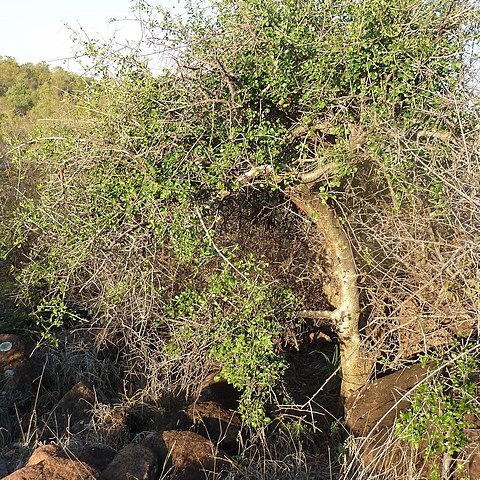Leaves 3-foliolate or pinnate with the leaflets 2-jugate (rarely 3-jugate); petiole up to 4·5 cm. long, sometimes sparsely pilose, slender and often twisted; terminal leaflet up to 5·8 × 3 cm., obovate to broadly obovate, apex rounded, base gradually cuneate, lateral leaflets up to 4 × 2·5 cm., elliptic, broadly elliptic or obovate, apex obtuse, base cuneate; all leaflets with margins entire or with a few crenations near the apex, glabrous, glaucous; petiolules up to 1 mm. long.
A shrub or tree. It loses its leaves during the year. It grows up to 8-12 m tall. The bark is pale grey and peels off. The bark is blue-green underneath. The leaves have 3 leaflets or 2-4 pairs along the stalk with one at the end. The leaflets are narrowly oval. There can be teeth along the edge. Male and female flowers are on separate trees. The flowers are small and yellowish-green. They are in clusters on long stalks. The fruit are round and red when ripe.
Tree, up to 12 m high. Bark usually peeling in large white papery pieces to expose glaucous underlayer. Leaves 3-foliolate or imparipinnate, glaucous, yellowish green or green; terminal leaflets elliptic, broadly elliptic or obovate, 12-65 x 7-30 mm. Fruit subglobose and not beaked. Pseudo-aril with 4 arms. Flowers yellowish green.
Flowers appearing with the very young leaves, in axillary paniculate cymes up to 4 cm. long or the female inflorescences reduced to 1–2-flowered abbreviated cymes; branches of inflorescence very slender; bracteoles c. 3 mm. long, filamentous, pubescent; pedicels up to 3 mm. long, slender.
Fruit c. 1·2 cm. in diam., globose, somewhat flattened; pseudaril covering about 2/3 of the endocarp and becoming thin above; endocarp c. 1 × 0·75 cm., subcordiform, smooth, both faces moderately convex.
Bush or small tree up to 5 m. tall, usually glabrous except for the bracteoles; bark smooth, peeling in whitish strips, under layer dark green.
Calyx c. 3–5 mm., long, infundibuliform, lobed to about 1/3-way.
Stamen-filaments flattened and broadened towards the base.
Disk-lobes not developed.
Petals 2–3 mm. long.


